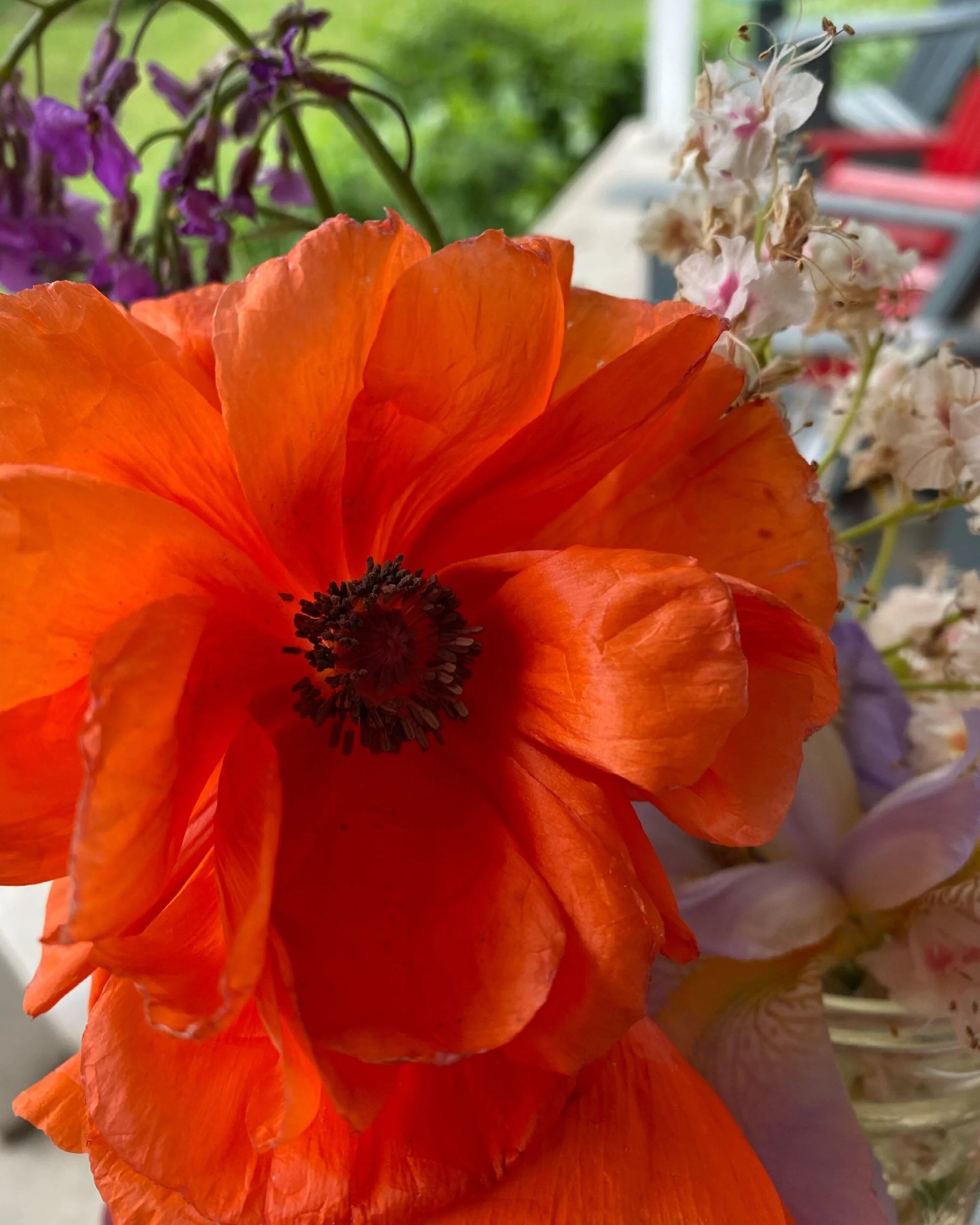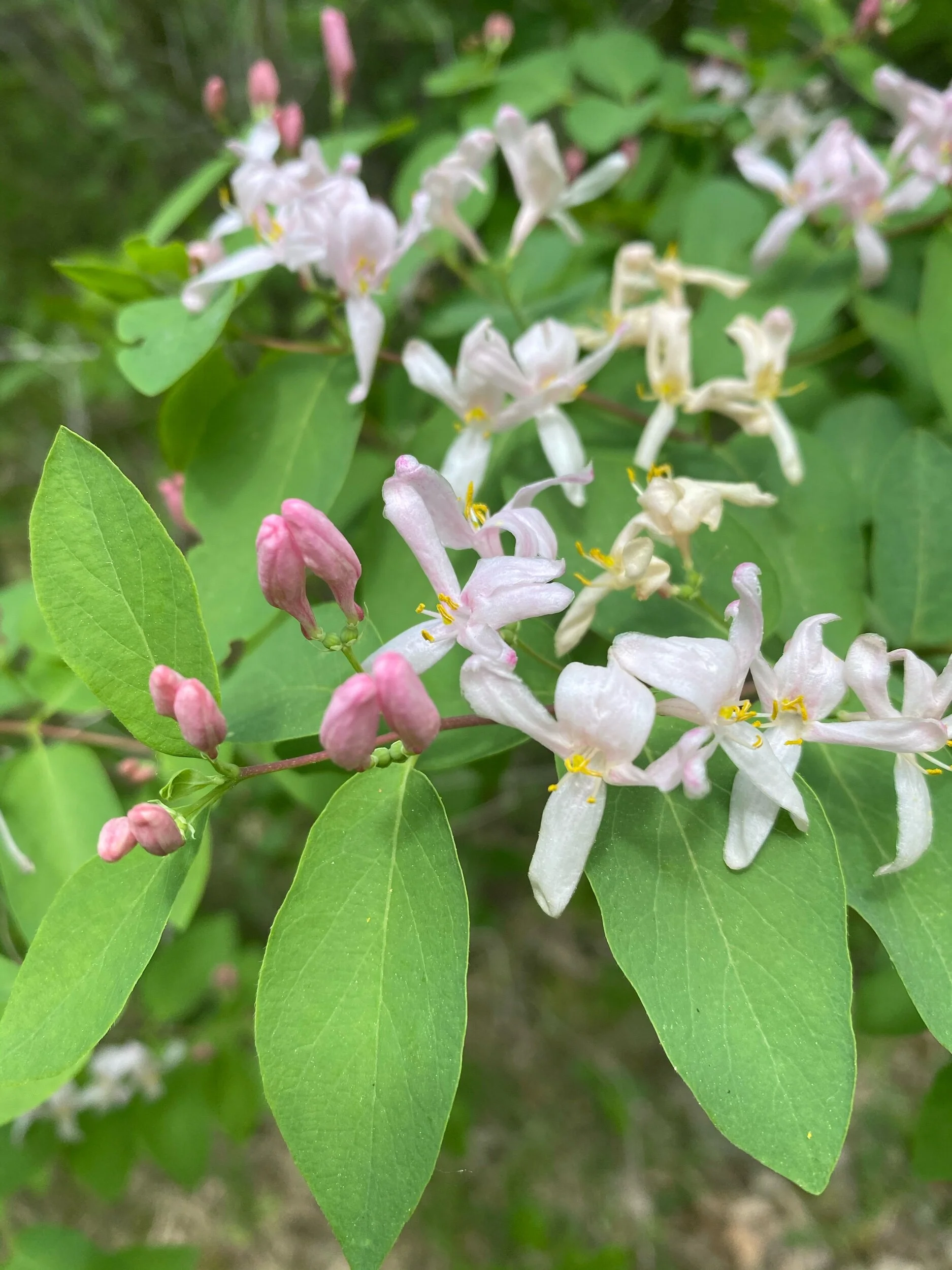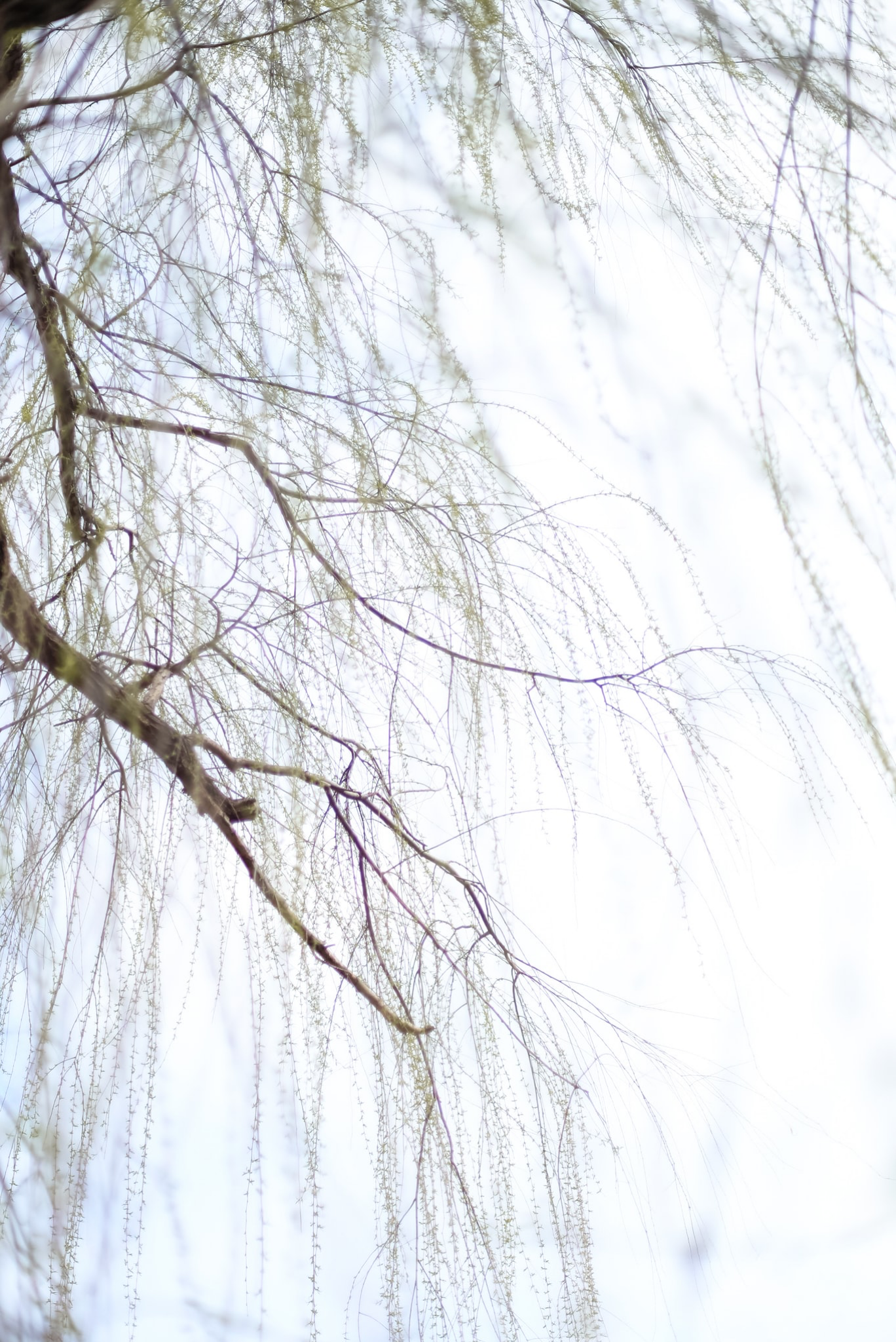Ideally, your children will participate in the daily life of your family, supported by the rhythms and activities sent by the teachers. In the Getting Started post we suggested a daily rhythm similar to the structure of our day in Nature Kindergarten. We encourage each family to use this material in the way that works best for them. We’re here to support you!
If you are looking for resources, songs and poems that have been shared previously on the blog, you can use the search tool on this page.
The days and nights are getting warmer. The sun is staying up later in the evening. There is a greenish hue to the branches of the deciduous trees. The birds are busy building nests or caring for freshly hatched chicks. (We have two pairs of robins who have chosen to build nests on the sides of our house!!). The forest is full of sweet scents. It is getting easier to be outside as we shed layers of clothing. Oh - the merry month of May! We welcome you!
SEASONAL POEMS:
MY GARDEN
This is my wee garden plot (Extend palm, point to it with index finger of other hand)
I’ll rake it with care and it will grow a lot! (Make rake with spread fingers and stroke it over palm)
Peas and carrots and salad from seeds (Poke index finger around palm to plant seeds)
I’ll plant and water and pull out the weeds (Extend thumb from fist to pour; pinch palm to weed)
The sun will shine and bathe my garden in light, (Flex and contract fingers)
All the plants will be happy and taste just right! (Face palms up and wiggle fingers)
Here, try some, have a bite! (Extend garden palm outward, pick plant, pop into mouth, and chew)
~ Betty Jones
SEASONAL SONG:
WILLOW TREE SONG
Down by the brook with her feet in the water
Stands the green willow, green willow
And she dances and sways in the heart of the winds so.
Grow the green willow, green willow.
CHORUS
Willow, dream with your roots in the water,
Willow, dance with your head in the sky.
Graceful and green, you’re the forest man’s daughter.
Grow the green willow, green willow.
We’ll dance round the willow who grows by the water,
Dance in the wind and the sky oh.
We’ll dance in the water with never a care oh,
Round the green willow, green willow.
Through the whispering leaves in the silver moonlight,
The song of the river is calling.
‘The song of your heart knows the dream you must follow,’
Whispers the willow, green willow.
MORNING ADVENTURE
Pack your backpack with a snack, water, and extra clothes and get ready to hit the trail (or your backyard!).
CAN YOU FIND THESE SPRING PLANTS?
On your adventures this week, look for these spring plant friends? One of these friends can be found in gardens and the other prefers the forest floor.
ANEMONE
These beautiful, tiny flowers are part of the buttercup family.
DAFFODIL
This cheery flower symbolizes rebirth and new beginnings.
FORAGING FOR FOREST FOOD
**Important disclaimer: Never eat anything from the wild without first consulting an expert! Please forage responsibly. Educate yourself, and have fun.
TROUT-LILY
Commonly called trout lilies, fawn lilies, or dog's-tooth violets, these are some of the first wild edible plants to show up in the spring. The mottled leaves are said to look like spots on a trout, and the underground corm is shaped like a dog's canine tooth.
Trout lilies are small plants with one or two 3"-7" lance-shaped leaves growing from the underground corm, or small bulb. Each leaf tapers at the ends, and is a dull green mottled with greyish-purple spots that often fade as spring advances. A single flower is produced on a 4"-8" stem growing directly from the base of the plant. The flower has six backward curving petals and protruding stamens, and the whole flower often appears to be pointing downwards. There are 23 species of Erythronium lilies native to North America, and our local trout lily has a yellow flower, but other species can have pink or white flowers.
How to prepare:
The leaves can be eaten raw in a salad. They do have a slightly bitter taste.
The leaves can be boiled and then eaten.
The underground corms can be boiled for 20-25 minutes and served with butter.
The corms can also be eaten raw in a salad. *The taste of the corm in the earliest parts of the spring are very sweet, since they are full of natural sugars that the plant needs to produce leaves and its flower. As the season progresses, the corm will become more firm and starchy, but still tasty.
WILD LEEKS / RAMPS
2 to 3 broad, smooth, light green, onion-scented leaves appear in spring and wither before its flower appears. The bulb underground is whitish and strongly onion-scented. Usually found in deciduous woods. When foraging, only pick ONE leaf from each individual plant. If you choose to harvest the whole bulb and leaves, please forage sparingly and in densely populated patches. These plants reproduce incredibly slowly in the wild.
This is a plant takes 7-15 years to mature and multiply. Patches that are over harvested can take many, many years to recover. We encourage ethical harvesting of Wild Leeks in order to keep them as an important part of the forest ecosystem. Wild Leeks are very strong in flavor. A little goes a long way in recipes and remember you cannot substitute Wild Leeks for traditional Leeks. Take only what you need, and use what you take.
How to prepare:
Slice up the leaves and add them to an omelette or frittata
SEASONAL STORY
This week’s story is Tough Chicks written by Cece Meng.
RECIPE
SUN TEA
Now that the sun’s rays have gained more heat, it’s the perfect time of year to make some sun tea!
Materials:
A large mason jar or glass water dispenser
Potable water
Plants that are safe to consume: thyme, mint, lavender, rosemary, lemon balm, clover flowers, dandelion petals, lilac blossoms, red or white pine needles, cedar leaves. You can make any combination of flavours you would like.
Lemon juice (optional)
Honey or maple syrup to sweeten (optional)
Instructions:
Harvest the plant materials.
Fill the mason jar with water.
Add the plant materials to the water.
Cover the jar and let it sit in the sun for several hours. The longer that you let it sit the stronger the tea will be.
Add lemon juice and honey or maple syrup and serve!
CRAFT
This craft comes to us from The Children’s Forest written by Dawn Casey, Anna Richardson and Helen d’Ascoli.
MAGIC POUCH
A magic pouch can contain a choice of forest treasures selected by the child. It could contain a rock that reminds them of a special place they have visited or an experience they shared. Other treasures in the pouch might offer practical help, such as a whistle to call your friends or a herbal remedy to heal a friend in need. The treasures in the pouch can be changed seasonally or as often as the child would like.
Materials:
Step 1 - cut out a circle and place holes evenly around the circumference.
Cloth - leather, cotton or felt (a piece of an old wool blanket)
Scissors
Wool or string
Beads (optional)
Instructions:
Draw a large circle on the cloth. (Using a dinner plate works well for a medium-sized pouch). Cut out and mark equally spaced dots for the holes. A simple way to do this by eye is to mark the centre and four quarters. Now mark the points in between, so that there are eight marks in total. For a dinner-plate sized pouch, mark two evenly spaced dots between each of these, until the circle has 16 dots, which can now be carefully cut to make the holes.
To make a cord to close the pouch, you can choose either of the following methods:
Single-cord drawstring - cut a length of cord which is at least twice the width of the bag, plus a bit extra. Thread from the outside, leaving one length hanging. Thread in and out through all the holes until the cord emerges out of the last hole. HOlding the ends of the string together, tie a knot. This can now be pulled to close the bag.
Double-cord drawstring - cut two lengths of good strong string or wool, approximately twice the diameter of the pouch. Take one piece of string and begin to thread the string through the holes, with the back end of the string dangling on the outside of the bag. After you have reached halfway add a bead to the threading end and push it along the string, up to the hole. Continue threading and at completion tie the two ends together with a knot. Now begin to thread the second string in through one of the holes next to the bead, leaving the end dangling outside as before. Thread in and out until the halfway point, and then thread a bead. Continue until you reach the end and tie the two ends with a knot. The two knot ends can now be pulled to close the pouch. To open, pull the beads.
Single-drawstring
Double-drawstring
THE WILLOW TREE
Excerpt from The Children’s Forest written by Dawn Casey, Anna Richardson and Helen d’Ascoli.
The Nature Kindergarten class loves to visit this big old willow tree in Jackson Creek Park.
WILLOW
CHARACTER:
I am Willow, Tree of Dreams.
I love to grow by the water, reaching my roots into the damp earth as my leaves reflect in the shimmering currents.
In spring see my catkins, pussy willows, silver and soft, shining in the sun, soon to turn gold with pollen before my white downy seed-children are carried away by the wind.
See the willow warblers in my trees; listen to their sweet song, like a flowing stream.
My branches are elegant and supple, with dancing leaves of green and silver swaying in the wind. Spend time with me; see how I move, feel all resistance fall away as you bend gently in the wind, soft and free.
Weave a basket from my flexible branches as your ancestors have done for many ages. Hold a strong vision of the shape you wish to make. Follow the patterns, the rhythm, the dance between your hands and my branches. I shall become a basket to hold all that you wish to gather.
Where I fall, I may sprout anew, for I am filled with the power of vigorous life and grow with ease.
If you take some of my shoots to craft, cut small piece of two and push them into the damp earth. They will easily root and begin to grow.
Grow into the dream you carry within you. My roots are in the river, connected to the flow of life. The River of Life is guiding your way; your heart knows where it is calling.
Come and sit beneath my tree by a woodland stream and look up into the green boughs. Listen to the waters and the whisper of the wind, and follow your dreams.
GIFTS
When dry and seasoned, my wood can be used to make fire by friction.
My roots offer a purple dye, my leaves a dye the colour of cinnamon.
My bark contains the main ingredient of aspirin.
Tea made from my bark offers a remedy for many ailments caused by damp, such as stiff muscles and rheumatism.
My leaves, after being chewed to make a simple poultice, ca be applied to a cut to help stop bleeding.
Tea from my leaves soothes sore throats, colds and fevers. If you feel stiff and sore, I will ease your pain and help you to flow free.
MORE RESOURCES
This is a fantastic website that has inspired me for many years. It has lots of wonderful resources and suggestions for Waldorf-Inspired activities to do with your children. Visit Meagan Rose Wilson.
CONNECT WITH COMMUNITY
You have the opportunity to connect with other parents and families on the Nature (home)School journey through a private Facebook group. The digital forum is a place where you can post photos of the activities that you get up to with your children, share stories or inspirations from your outdoor adventures, and connect with other families. Please follow the link to connect with other families in the online community or from Facebook - search: Nature (home)School Support.
We are a very small Not For Profit School. If you like these resources and find them helpful, please consider making a donation to our Nature Kindergarten program. We appreciate your support!

















